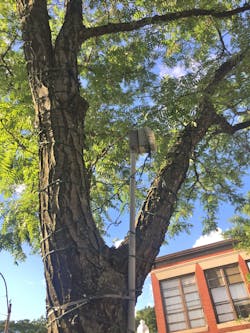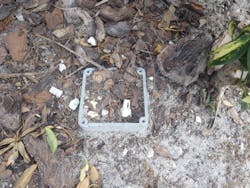Illustrated Catastrophes: A Permanent Temporary Installation
All references are based on the 2023 edition of the NEC.
A Permanent Temporary Installation
Slapping a box on the end of rigid PVC conduit is no way to properly support and secure a box. This method is not one of the methods specified in Sec. 314.23(A) through (H) and is prohibited by Sec. 352.12(B). Section 314.23(E) and (F) both permit raceway-supported enclosures. However, in both cases, the enclosure must have threaded entries or hubs, and conduits must be threaded into the enclosures. Using PVC glue to hold the box in place simply will not “make the grade.” If I was the AHJ inspecting this installation, I would fail it without hesitation. On a positive note, at least the installer used a weatherproof while in use cover, (aka a “bubble cover”) as required by Sec. 406.9(B)(1). However, I’m not so sure it is an “extra-duty” type of cover as required by that same Section though. One other problem to note is the string of holiday twinkle lights that remain plugged in year-round. These lights are designed for temporary use only and are limited to 90 days as specified in Sec. 590.3(B). The product standard for seasonal decorative-lighting products, ANSI/UL 588, also limits their use to 90 days per year. Leaving them up all year violates Sec. 110.3(B).
Danger Underfoot!
Walking through the mulch bed of this landscaped area near a hotel presented me with an unexpected find. I almost stepped on this partially buried PVC junction box. With the cover missing, the circuit wires and wire connectors are now left exposed. The open box is full of mulch and sand and can easily fill with water when it rains. The exposed wire connector is split open with its metal spring visible. This situation elevates the risk of shock to any animals or people walking through this area as I did. That box needs to have all the debris cleaned out. The conductors and connectors should then be inspected for damage and replaced as needed. A cover should be installed on the box as required by Sec. 314.25 and Sec. 314.28(C). One side of the box is cracked, so the box may need to be completely replaced too. Until these repairs are made, this circuit poses a real shock hazard when energized. An exception in Sec. 314.29(B) permits listed boxes to be installed underground where covered by gravel, light aggregate, or noncohesive soil if their location is described and accessible for excavation.
About the Author

Russ LeBlanc
Owner
Russ started in the electrical trade as an apprentice in 1985. He worked his way up to become a Journeyman Electrician and then eventually became a Master Electrician and Licensed Construction Supervisor. In 1999 Russ become an Electrical Instructor for The Peterson School of Engineering in Massachusetts where he developed his passion for teaching, and quickly became Department Head of Electrical Instruction. Russ has taught thousands of apprentices, electricians, engineers, inspectors, and other electrical professionals during his career as an instructor. He continues to provide electrical professionals with Electrical Code seminars, Arc-Flash Awareness training seminars and educational material through his LeBlanc Consulting Services in North Reading, MA whose specialty is educating electricians. He has been an active member of the NFPA Electrical Section and has authored hundreds of National Electrical Code proposals and comments which have become Code rules to improve the safety for the electrical industry. Russ is also an IAEI certified Electrical Inspector.
Please visit www.russleblanc.net for more information.


